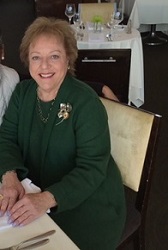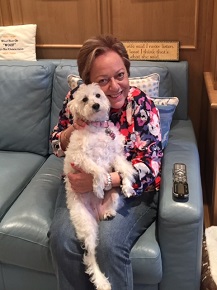Faces of COPD: Carol Rubin
Posted on March 08, 2018 |
Carol Rubin is one of the newest members of the COPD Foundation’s State Advocacy Program. Learn more about life with COPD below.
Having grown up in the Bronx, New York, I was exposed to all the wonderful cultural entities that New York City has to offer. I’ve always loved the theater, museums, the NY Yankees. After I began my career with the NYC Department of Education as an educator, I moved to New Jersey, but very close to Manhattan to continue enjoying the life of a “Native New Yorker.”
 Throughout the years, I became involved in volunteer work, fundraising, and traveling. After retiring as a principal, I began a second career, part-time as an adjunct professor at a local college, going to different schools to supervise student teachers and doing consulting work. During my visits to student teachers, I went to some old school buildings that had 5 to 6 floors with no elevators. It was during these visits that I experienced shortness of breath going up the stairs. Then, I suffered shortness of breath from walking uphill and doing activities that required lifting, bending, reaching (changing bedding). At first, I justified that I was out of shape, should lose weight (as so many others with COPD rationalize).
Throughout the years, I became involved in volunteer work, fundraising, and traveling. After retiring as a principal, I began a second career, part-time as an adjunct professor at a local college, going to different schools to supervise student teachers and doing consulting work. During my visits to student teachers, I went to some old school buildings that had 5 to 6 floors with no elevators. It was during these visits that I experienced shortness of breath going up the stairs. Then, I suffered shortness of breath from walking uphill and doing activities that required lifting, bending, reaching (changing bedding). At first, I justified that I was out of shape, should lose weight (as so many others with COPD rationalize).
As the shortness of breath became more frequent, I went to a cardiologist who had me take a stress test and echocardiogram. The results were good; my heart was fine. This went on for another year. Once again I went through a stress test and echocardiogram and once again, the results were good. I never connected my symptoms with respiratory problems or my history of smoking because although I was a smoker for many years, I had stopped smoking 20 years ago.
I knew my situation wasn’t normal and my cardiologist then referred me to a pulmonologist. This was in December of 2014. After a pulmonary function test, I was immediately diagnosed with moderate emphysema and I was prescribed two maintenance inhalers, a rescue inhaler and a pill to reduce the risk of exacerbations. When I returned to the doctor for a follow-up visit several weeks later, I was told my lung capacity improved 20%; the medication was successful. I then registered for a pulmonary rehab program that was in a hospital, close to home.
 Several months after my diagnosis, I decided to seek a second opinion. I knew the diagnosis was correct but since this disease is forever, I wanted to be assured that my treatment was the best. I went to a pulmonologist at New York Presbyterian Hospital. In the waiting room I came across COPD Foundation magazines. That was my introduction to the COPD Foundation. The new pulmonologist was much more thorough than the first and I discovered that I was on the wrong medication. The maintenance inhalers were for treating chronic bronchitis (not emphysema) and the pill was for patients with bronchitis and a history of exacerbations; I had neither. My new physician prescribed one maintenance inhaler and a rescue inhaler (“less is better”) and using them has kept my condition stabilized.
Several months after my diagnosis, I decided to seek a second opinion. I knew the diagnosis was correct but since this disease is forever, I wanted to be assured that my treatment was the best. I went to a pulmonologist at New York Presbyterian Hospital. In the waiting room I came across COPD Foundation magazines. That was my introduction to the COPD Foundation. The new pulmonologist was much more thorough than the first and I discovered that I was on the wrong medication. The maintenance inhalers were for treating chronic bronchitis (not emphysema) and the pill was for patients with bronchitis and a history of exacerbations; I had neither. My new physician prescribed one maintenance inhaler and a rescue inhaler (“less is better”) and using them has kept my condition stabilized.
Therefore, I recommend second medical opinions for patients with COPD; it certainly has had a positive impact on my life. In discovering the existence of the COPD Foundation through the magazines in the waiting room, I learned that my new pulmonologist, Dr. Byron Thomashow was a co-founder of the Foundation as well as its Chairman of the Board. I actively read about the Foundation and its mission that always represents the best interests of the COPD patients. Fortunately, I attended the COPD Foundation’s biennial conference in Chicago last summer. It was life changing for me. I learned about all aspects of the illness from medical providers, scientists, researchers, respiratory therapists, insurance providers and patients, as well as the Foundation’s emphasis on patient care and the quest for a cure. I have since become a volunteer for certain projects for the Foundation.
I continue with pulmonary rehab and probably will forever. The respiratory therapists are like personal trainers; the patients are like a family and support each other. Most importantly, the exercise is both mentally and physically beneficial. I also follow a healthy diet, always trying to lose that extra 10 or so pounds.
Besides improving my life with a healthy diet, exercise and medication, my life has changed in the way I’ve learned to deal with certain weather conditions. Rain with wind and/or cold weather, extreme heat, humidity are possible triggers that could result in shortness of breath. I have a small dehumidifier in the bathroom because the dampness from a shower could affect my breathing. My life is as normal as possible. I still travel and do volunteer work. I try to avoid situations that present the “triggers” that may cause me to have shortness of breath. My lungs are monitored twice a year via CAT scans and I work 24/7 to avoid anxiety and stress which can impact on COPD.
My advice for friends, family and caregivers of those who live with COPD is to be supportive, loving and encourage the patient to live as normal a life as possible. Ensure the patient is involved in an exercise program and proper diet, is properly taking prescribed medications and seek the care of a good pulmonologist who takes the total health and well-being of the patient into consideration. Become patient advocates to raise public awareness because COPD is the third largest cause of death after heart disease and cancer and more funding is needed in helping to find a cure.
If anyone is newly diagnosed with COPD, I recommend finding the best pulmonologist possible as I did, participate in a pulmonary rehab program (or regular exercise program), maintain a healthy diet, and read as much as possible about the disease. Find the appropriate support and get acquainted with the COPD Foundation, including COPD360social which connects patients with online support and dialogue with other COPD patients. Know that patients can improve their quality of life and they are not alone.